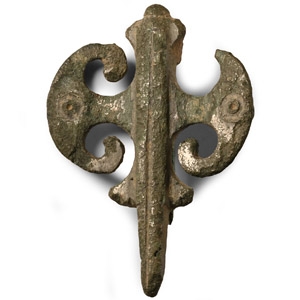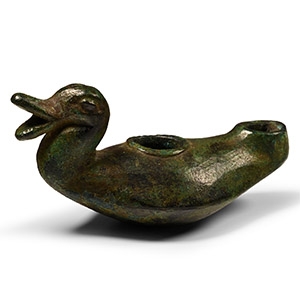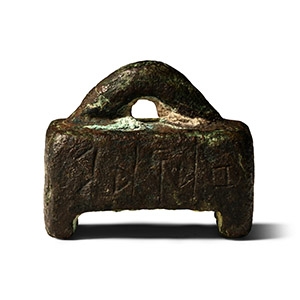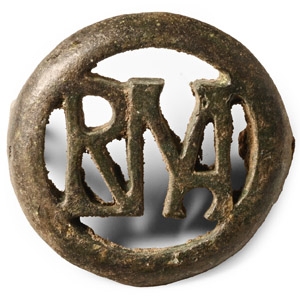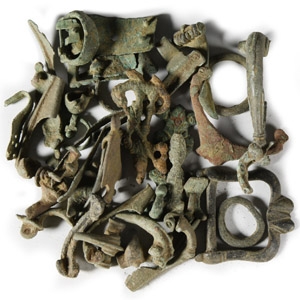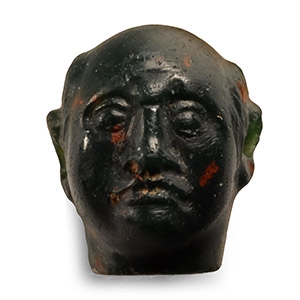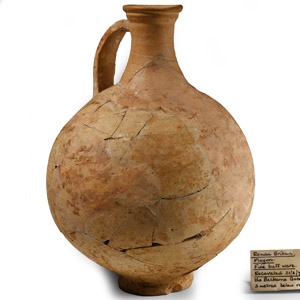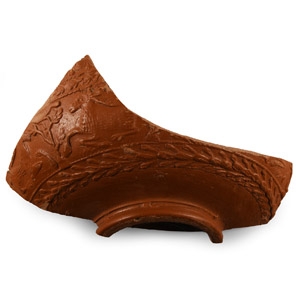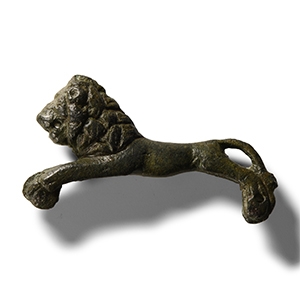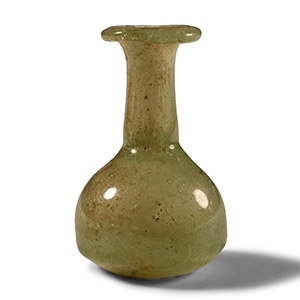Home > Auctions > 4 June - 8 June 2024
Ancient Art, Antiquities, Natural History & Coins
Auction Highlights:
UK art market, acquired prior to 1980.
Property of a Kent lady collector.
Cf. Hattatt, R., Ancient Brooches and Other Artefacts, Oxford, 1989, item 1630.
Acquired on the German art market, 1989-1995.
with The Museum Gallery, 19 Bury Place, London, WC1A 2JB, 1998-2003.
Property of a London based academic, 2003-present.
Cf. for the type (but with different handle) Gökalp, Z.D., ‘Some examples of Byzantine bronze lamps in Turkish Museums’ in Actes du 1er Congres International d’etudes sur le Luminaire Antique (Nyon-Geneve, 29.IX-4.X.2003), Monographies Instrumentum 31, (2005), pp. 69-71, figs.3-4-5-6, pl.30.
The lamp belongs to the category of lamps with flattened spherical bodies, that have a certain number of variations in their nozzle, handle, lid and base designs. The most common form, like here, is that in which the body is heightened towards the front to form the nozzle. Many examples have oyster shell shaped lids which are connected to the body with hinges.
Found UK.
From the collection of a late East Anglian teacher and antiquarian who retired to the Isle of Wight in Hampshire, UK.
He amassed a large collection of objects between the 1960s-1980s.
Accompanied by handwritten information display cards.
with Hotel des Ventes, Drouot, Paris, France.
From the collection of Mr H. Naudy, Paris, France.
Acquired at between 2004-2010.
Property of a French collector.
Cf. Willi, A., Manual of Roman Everyday Writing Volume 2, Writing Equipment, Nottingham, 2021, fig.5, for similar object on a sculpture.
This small counter-weight bears letters indicating numbers: on one of the short sides Α (1), Δ (4), Χ (600); on the other short side they worn and difficult to read; and on one of the longer sides Υ (400), φ (500). The other letters are challenging to read, but the object would have been used as unit of measure. Another possibility is that it belonged to a statuette of a man holding a codex ansatus (box with a handle for carrying writing tablets).
Ex German art market, 2000s.
Acquired from an EU collector living in London.
From the collection of Surrey, UK, gentleman.
The brooch is engraved with stylised letters ‘RMA’. When viewed from the default side, RMA + the circle of the brooch form a monogram for ‘Roma’. Roma refers to both the city and its divine personification, the Dea Roma. When RMA is read from right to left (or the brooch is viewed from the opposite side), the letters form a monogram for ‘AMOR’, the Latin name for Cupid, the god of love. The phrase pertains to Roma-Amor, a widely recognised palindrome espousing Roman wordplay in the ancient times.
Found Gloucestershire, UK.
Found Gloucestershire, UK.
From the glyptic collection of Mr X; thence by descent.
Acquired Hotel des Ventes, Drouot, Eve SVV, Paris, France, 28 June 2017, no.152 (Part).
Property of a French collector.
Excavated near Balkerne Gate, Colchester, UK, on 21st March 1976, by R.
McCluskey.
From the collection of a late East Anglian teacher and antiquarian who retired to the Isle of Wight in Hampshire, UK.
He amassed a large collection of objects between the 1960s-1980s.
Accompanied by an old handwritten information card.
Found Colchester, Essex, UK, 1972.
From the collection of a late East Anglian teacher and antiquarian who retired to the Isle of Wight in Hampshire, UK.
He amassed a large collection of objects between the 1960s-1980s.
Found Essex, UK.
Property of an Essex collector.
Acquired from Allan Cherry, Bournemouth, UK, 2004.
Ian Wilkinson collection, Nottinghamshire, UK.
481 - 492 of 2809 LOTS

.jpg)

.jpg)
.jpg)
.jpg)
